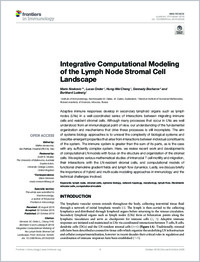Integrative Computational Modeling of the Lymph Node Stromal Cell Landscape.
- Novkovic M Institute of Immunobiology, Kantonsspital St. Gallen, St. Gallen, Switzerland.
- Onder L Institute of Immunobiology, Kantonsspital St. Gallen, St. Gallen, Switzerland.
- Cheng HW Institute of Immunobiology, Kantonsspital St. Gallen, St. Gallen, Switzerland.
- Bocharov G Marchuk Institute of Numerical Mathematics, Russian Academy of Sciences, Moscow, Russia.
- Ludewig B Institute of Immunobiology, Kantonsspital St. Gallen, St. Gallen, Switzerland.
- 2018-11-09
Published in:
- Frontiers in immunology. - 2018
computational models
fibroblastic reticular cells
lymph flow
lymph node
morphology
network topology
stromal cells
systems biology
Animals
Chemotaxis
Computational Biology
Computer Simulation
Humans
Lymph Nodes
Models, Theoretical
Stromal Cells
Systems Biology
T-Lymphocytes
English
Adaptive immune responses develop in secondary lymphoid organs such as lymph nodes (LNs) in a well-coordinated series of interactions between migrating immune cells and resident stromal cells. Although many processes that occur in LNs are well understood from an immunological point of view, our understanding of the fundamental organization and mechanisms that drive these processes is still incomplete. The aim of systems biology approaches is to unravel the complexity of biological systems and describe emergent properties that arise from interactions between individual constituents of the system. The immune system is greater than the sum of its parts, as is the case with any sufficiently complex system. Here, we review recent work and developments of computational LN models with focus on the structure and organization of the stromal cells. We explore various mathematical studies of intranodal T cell motility and migration, their interactions with the LN-resident stromal cells, and computational models of functional chemokine gradient fields and lymph flow dynamics. Lastly, we discuss briefly the importance of hybrid and multi-scale modeling approaches in immunology and the technical challenges involved.
- Language
-
- English
- Open access status
- gold
- Identifiers
-
- DOI 10.3389/fimmu.2018.02428
- PMID 30405623
- Persistent URL
- https://folia.unifr.ch/global/documents/55766
Statistics
Document views: 26
File downloads:
- fulltext.pdf: 0
